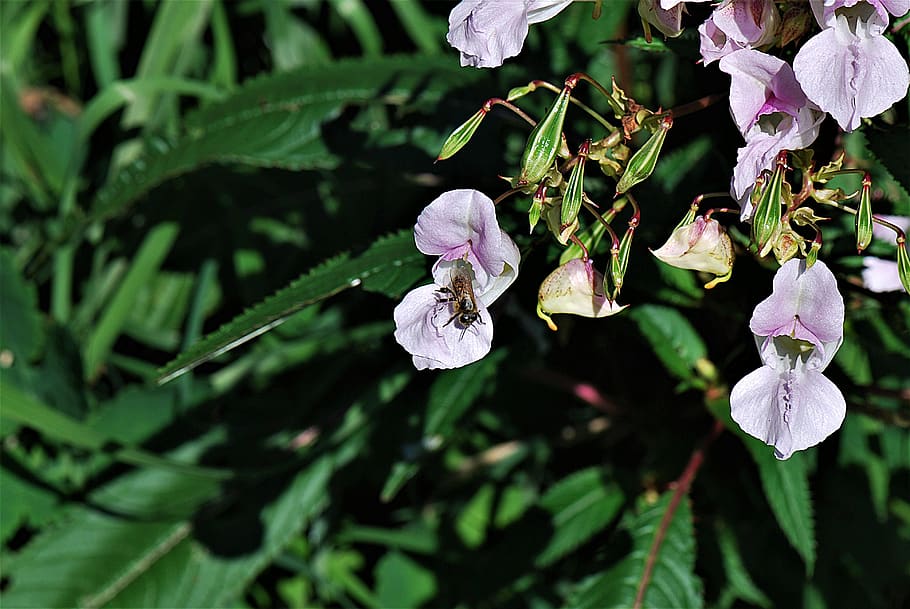Banish bugs from your Balsam Fir and keep it thriving with these proven pest control tactics!
With their delicate colorful blooms balsam plants bring charm and vibrancy to any garden. However, lurking beneath those pretty petals are pesky insects and diseases waiting to strike. Don’t let pests turn your balsams into plant bullies! Learn how to spot infestations early and take control with integrated, eco-friendly treatments.
Aphids – Tiny Sap Suckers
Of all balsam pests, tiny aphids lead the charge These pear-shaped insects congregate on stems and undersides of leaves, piercing plants to suck out nutrients Heavy feeding causes curled, yellowing leaves and stunted plants.
ID tips Check for clusters of green yellow or black soft-bodied insects. Watch for sticky “honeydew” residue left on foliage.
Organic treatments: Knock off with water spray. Apply insecticidal soap or neem oil. Introduce ladybugs.
Spider Mites – Microscopic Biters
Barely visible to the naked eye, spider mites are another sap feeding pest that afflicts balsams. These tiny arachnids colonize leaves, extracting contents and leaving behind dots of chlorophyll loss. Fine webbing may cover heavily infested plants.
ID tips: Look for stippling damage on leaves. Shake foliage over white paper to spot tiny specks crawling.
Organic treatments: Mist regularly. Apply insecticidal soap or horticultural oil. Release predatory mites.
Whiteflies – Fluttering Clouds
Resembling miniature moths, whiteflies congregate and feed on leaf undersides. As sap-suckers, they cause yellowing leaves and growth decline. They release sticky honeydew that promotes black sooty mold.
ID tips: Gently disturb leaves to reveal clouds of tiny white insects flying up. Check for honeydew and black sooty mold.
Organic treatments: Use yellow sticky traps. Apply insecticidal soap or neem oil. Release mini wasps.
Thrips – Stealthy Scavengers
Shaped like grains of rice, thrips rasp leaf surfaces and feed on expelled plant juices. This causes blotchy spots, distorted growth and injured flower petals. They move rapidly making detection tricky.
ID tips: Look for tiny elongated insects inside flowers. Check for black dots of frass (poop!) on leaves.
Organic treatments: Prune damaged parts. Spray insecticidal soap or neem oil. Use blue sticky traps.
Scales – Armored Adversaries
Appearing as bumps or swollen areas on stems and leaves, scale insects pierce plants and feed on sap. Their protective outer coating resists sprays. Honeydew secretions encourage sooty mold growth.
ID tips: Look for unusual lumps, bumps or swollen areas on plant parts. Check undersides of leaves for encrustations.
Organic treatments: Apply horticultural oil or insecticidal soap directly to scales. Use alcohol swabs to scrub off.
Downy Mildew – Leaf Spotter
The fungal disease downy mildew causes light green, yellow or brown spots on balsam leaves. Gray fungal growth may appear on the undersides in wet weather. Lower leaves are affected first.
ID tips: Look for specified leaf spot colors first appearing on oldest foliage. Check undersides for gray fuzz.
Organic treatments: Improve airflow. Prune affected parts. Apply neem oil or sulfur early preventatively.
Powdery Mildew – Surface Spotter
Unlike downy mildew, powdery mildew doesn’t penetrate leaf surfaces. It feeds on outer cells, forming a white or gray powdery coating on leaves. New foliage is most susceptible.
ID tips: Look for characteristic white powdery substance on upper leaf surfaces and new growth.
Organic treatments: Space plants for airflow. Apply neem oil or potassium bicarbonate early preventatively.
Botrytis Blight – Bud Bummer
The fungus Botrytis cinerea causes ugly brown lesions and soft decay on balsam buds, flowers and stems. Petals turn mushy and gray as the fungus rapidly spreads. High humidity encourages this disease.
ID tips: Look for gray, mushy plant parts – especially on flowers and buds.
Organic treatments: Improve airflow and reduce humidity. Remove affected parts promptly. Apply neem oil or sulfur preventatively.
By properly identifying balsam pests and diseases and taking prompt organic action, you can keep your plants happy and healthy. Pay close attention and don’t hesitate to intervene early against potential bullies! Your garden will thank you with a bounty of beautiful balsam blooms.

Fungus Gnats and Fruit Flies: Root Ruiners in Disguise
Spot larvae in the soil or adults buzzing around. Theyre not just annoying; theyre harmful.
Dry out the soil and reduce watering. For an infestation, insecticidal soaps or sticky traps are your allies.
Mealybugs: The White Cottony Curse
Mealybugs flaunt their white, cottony hideouts. Theyre not just ugly; theyre sap-suckers.
Wipe them out with alcohol-dipped swabs or spray with horticultural oil. For a full-blown invasion, systemic insecticides are the nuclear option.
The Ultimate Guide To Plant Pests
FAQ
How to treat balsam woolly adelgid?
What are signs of common plant pests?
Is Himalayan Balsam a pest?
Join the Fight Against This Invasive Plant! Himalayan Balsam is an Invasive Non-Native Species and a pest plant. It is present in this area and likely to spread, finding niches away from the River Wye, in gardens, woodlands, orchards, along our paths and bridleways.
What is a balsam plant?
Balsam plants, also known as Impatiens balsamina, are known for their vibrant and colorful flowers that brighten up gardens and landscapes. While the flowers are the main attraction, understanding the root and stem structure of balsam plants is crucial for their overall health and growth.
What are the roots and stems of a balsam plant?
In this article, we will take an in-depth look at the roots and stems of the balsam plant. The root system of the balsam plant plays a vital role in its overall health and survival. Balsam plants have a fibrous root system that consists of numerous thin, branching roots that spread out horizontally in the soil.
What is balsam bashing?
If you can, celebrate achievements with social events, e.g. a barbecue. ‘Balsam bashing’ is the practice of manually pulling up balsam plants with roots, and/or cutting plants below the bottom node using scythes, slashers, brush-cutters or flails, to stop the plants forming seeds.
